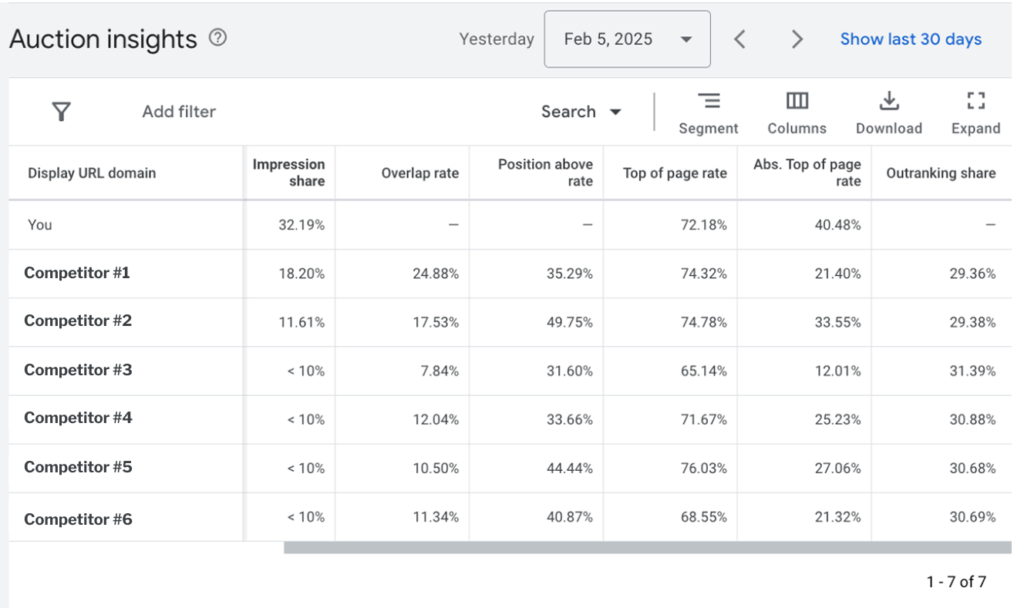A Digital Marketer’s Guide to Completing a Competitive Analysis

How to Perform Competitive Marketing Research

Changes happen quickly in most industries, with new technologies, product offerings, and strategies emerging almost daily. This can make it hard to keep up with what's new, what's trending, and what's up next.
As digital marketers, it's important for us to keep a finger on the pulse and stay up to date with the latest developments in any landscape. One of the ways we can do this is through competitive research.
If you’re new to this kind of marketing research or have never performed a competitive analysis before, you’re in the right place. This guide will break down how to perform a competitive analysis so you can stay aware of what's happening in your industry and make better, more informed decisions.
What is a Competitive Analysis and Why Should You Complete One?
A competitive analysis is the process of identifying the competitors in your space and analyzing their content, offerings, and strategies. Performing a competitive analysis allows you to uncover specific information about your competition so you can better position yourself against others in your industry.
Here are just a few insights a competitive analysis can help you gain:
- Content Gaps
- Strengths and Weaknesses
- New Industry Trends
- New Competition
This analysis can be tailored to your specific industry and can be as brief or as in-depth as you need it to be. Let the information you find guide you and lead you in the best direction.
It's important to note that even though you’re analyzing your competitors, you shouldn’t copy what they’re doing or offering. Your analysis should be seen as a way to gain inspiration and helpful insights to make decisions that are unique to you, helping you to improve and better meet the needs of your audience.
5 Steps to Completing a Competitive Analysis
1. Identify Your Competitors
The first thing you’ll want to do is search for companies in your space that are similar to yours. These companies could have product offerings that are comparable to yours or may even have the same customer base as you. Narrow down these companies and make note of them for the upcoming steps.
2. Analyze Their Organic and Paid Marketing Presence
Once you know who your competitors are, you can take a deep dive into their marketing presence. Start by taking inventory of each platform they're on and what content they're creating for each.
Some questions you can ask to get started include:
- Are they on social media?
- What kinds of posts are they curating?
- How often are they posting?
- Are they running paid ads around their products and services?
- What platforms are they running ads on?
- What does their ad copy look like?
- What terms are they targeting?
- Do they have a blog on their website?
- What topics are they covering?
- How often are they posting?
- Do they post any other kinds of content like case studies, videos, guides, or eBooks?
- Is the content gated or available to all users?
- Are they using email marketing?
- Do they have a newsletter?
- How often are they sending emails?
- What content do they send and what calls to action are they using?
These are all questions to ask yourself while digging into their strategy.
Organic Research
Third-party tools like Semrush can be incredibly helpful to use when trying to gain a more well-rounded view of your competitors' strategies. Semrush allows you to view insights on your competitors' organic rankings, what keywords they’re ranking for, what ads they are or have been running, and more.
Below are the competitive research tools that Semrush offers:
- Domain Overview: Shows metrics like top organic keywords, paid position distribution, organic competitors, and more for a selected domain so you can gain an overview of their presence
- Traffic Analytics: Displays information specific to users and how they are accessing a specific site. In this section, you can learn more about traffic journeys, what channels are bringing in traffic, (organic, paid social, direct, etc.) and more.
- Organic Research: Offers a deeper look into organic-specific metrics, including what terms your competitors are ranking for, any ranking changes they have seen, what SERP features they may have, and more.
- Keyword Gap: Allows you to compare yourself and your competitor to see if there is any keyword overlap or gaps, and what keywords your competitors are ranking well for.
- Backlink Gap: Helps you identify opportunities for potential backlinks by comparing your site and a chosen competitor domain.
If you’re looking for other tools in addition to Semrush, the Google Ads Keyword Planner is great for viewing keyword volume, and also gives a range of bid amounts for each keyword option.
Ubersuggest is another option. A free trial provides a basic level of information on keyword traffic, which pages are top-performing for a particular domain, ideas for new keywords you can consider, and more.
Note: Third-party tools do not provide 100% accurate information, but they do offer helpful context to allow you to make a better-informed decision.
Paid Presence Research
For your paid competitive research, you should start by determining whether your competitors are even running ads in the first place. Google Ads, LinkedIn, Microsoft, and Meta have ad libraries that let you see who's running ads on their platform, as well as a library of ads they have created.
Below is an example of what the Google Ads Transparency Center looks like and where you would enter the name of the competitor or advertiser you’re looking to view:

For paid-specific insights and metrics, the Google Ads Auction Insights tool gives you a view into how you compare against competitors in the same auction as you. This tool can be found under Insights and Reports in the Google Ads platform.
It allows you to compare information like:
- Impression Share: This metric divides the number of impressions you received by the number of impressions you were eligible to receive. Eligibility is based on multiple factors, such as your targeting settings, quality score, and approval statuses.
- Overlap Rate: This rate shows how often another advertiser’s ad received an impression when your ad also received an impression.
- Position Above Rate: This metric shows how often a competitor’s ad showed above yours.
- Outranking Share: Similar to position above rate, outranking share shows how often your ads are being shown above other advertisers’ ads.
These metrics are important and can help you decide where you might need to optimize your paid strategy to better your chances in the ads auction. You should note, however, that some of the metrics listed above may not be available for every campaign type.

3. Outline Their Strengths and Weaknesses
After analyzing their marketing presence, is there anything in particular you think your competitors are doing really well?
For example, your specific competitor might be doing a great job at posting regular blog content that ties back to their products and services. Take note of these strengths and think about how you can adjust your strategies to find your own success.
On the other hand, where are your competitors not succeeding? What aren't they taking advantage of?
In line with the above example, maybe their blog content is disjointed and doesn’t relate well to a specific goal. Be aware of these weaknesses so you can avoid making the same mistakes.
In this same step, you should also look for any gaps that you can fill. Your customers may be looking for a specific service, product, or piece of content that your competitors don't offer. This is where you can step in to meet the needs of your customers.
4. Compare Your Offerings Against the Competition
Now you’ll compare how similar your offerings are to your competition. If you both have similar offerings, think about what makes you stand out against the crowd. Is there anything you offer that others in your space do not? Think about how you can communicate that to your customer base.
Also, if applicable, take note of things like pricing and even delivery times of your competitors' offerings. These can be huge competitive advantages and you should be aware of the norm in your industry so you know whether or not you’re within that benchmark.
5. Identify Areas for Improvement and Implement Changes
By the time you reach the final step of your competitive analysis, you should have a good idea of where you stand in your industry compared to your competition. You can now look at your own strategies with fresh eyes, and identify ways to optimize based on what your competitors are doing.
What to Do After You Complete Your Analysis
Once you've finished your analysis, you should have a more detailed view of your competitive landscape.
So, where do you go from here? Use the information you gathered to adjust your marketing strategy for the future. You can start proposing changes like new content for your website, updated ad copy, or a refreshed social media strategy.
Just keep your overall goal in mind and make sure each change you propose supports and ties back to that. Your updated strategies, backed by the research you gathered, should have a better chance of being successful and helping you achieve your goals.
If you still have questions on competitive research, or feel overwhelmed by the thought of completing an analysis, contact our team! We're always here to help.
We'll also be publishing more in-depth guides on SEO, PPC, and social media competitive research in the coming weeks - so keep an eye out for those!
Meet the Author

Alana Leveritte
Alana is a Digital Marketing Associate who works out of our Buffalo office. She started at Cypress North in December 2022 as a Digital Marketing Intern before joining us as a full-time employee in Spring 2023.
Since joining Cypress North, Alana has earned certifications in Google Analytics, Google Ads Search, Google Ads Measurements, and HubSpot Content Marketing.
Alana is a Buffalo native who studied at Niagara University, where she earned a Bachelor of Arts in communication and media studies. She returned to Niagara to earn her Master of Business Administration in strategic marketing. At school, Alana served as the Niagara University Multicultural Affairs Advisory Board Communications Secretary.
Outside of work, Alana is involved in the Young Professionals for Olmsted Parks program. She also enjoys finding and starting new hobbies, trying new restaurants in the Buffalo area, and traveling. She visited three different countries while studying abroad in high school and college.

